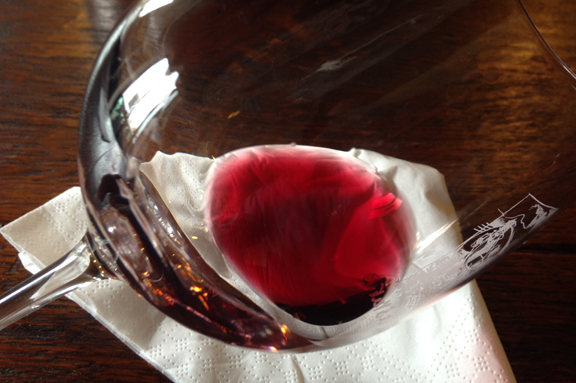
Wine Tasting Basics for Beginners
It’s already mid-January and the new year is about to get into full swing.
And so it seemed like a good time to get back to basics and brush up on the fundaments of wine tasting.
During the Boulder Burgundy Festival, when I sat down with Robert Bohr, one of the most dynamic wine professionals working in U.S. today, he reminded me that “wine tasting is like a muscle” and being a top taster is “like being an athlete.”
Of course, Robert belongs to an elite group of top wine tasters and professionals. I’m just a wine scribe who is fortunate enough to hang out with guys like him and — by osmosis — glean some insights into the great wines of the world, how to “apply” them, and how to appreciate them truly.

Above: Sangiovese should be bright and transparent, not dark and opaque.
But like any dedicated athlete, I’m always trying to “exercise” my tasting “muscle” so that I’m ready (or at least as ready as I can be) for whatever $15 bottle of Nero d’Avola or priceless bottle of Burgundy that might happen to be passed my way.
Here are the four classic elements of wine tasting that I always observe whether I’m just sitting down to dinner with my wife or friends or tasting with the pros like Robert.
Look at the Wine
Look at the wine and its color. Is it clear or cloudy? Transparent or opaque? If you can, hold the wine glass against a white surface like a napkin or table cloth (this is the best way to see the color and opacity/transparency of the wine). If you already know the wine, the color can tell you a lot about its “fitness” or “correctness.”
For example, a Chardonnay from California should be bright (not brown). A Sangiovese from Tuscany should be transparent (not opaque). But most important, take time to appreciate just how beautiful wine can be.
Smell the Wine
Swirl the wine in the glass and let it aerate a little bit. And then really stick your nose deep into the glass (or as deep as you can). What does it smell like? Does it smell like fruit? Does it smell like flowers? The “nose” of the wine also tells you a lot about its fitness.
If it smells rotten, it might be suffering from cork taint or from exposure to extreme temperature. How does the aroma change as the wine aerates? For many tasters (especially for me), the nose of the wine is what gives the greatest reward, especially with older wines.
Taste the Wine
When you put the wine in your mouth, swirl it well and make sure that it touches every part of your mouth — the roof, under your tongue, your gums etc. Before you swallow (or spit) the wine, open your lips slightly while still holding your teeth shut and draw some air into your mouth.
It’s not the most becoming thing but it helps the wine to aerate in your mouth and more fully release its flavor. What do you taste? Fruit? Earth? Can you taste the alcohol? The acidity? What’s the texture of the wine? Is it light or heavy? Is it viscous or lithe in your mouth?
Take Note of the “Finish” of the Wine
What impression does the wine leave in your mouth after you swallow (or spit) it? Does it linger on your palate and is the “finish” of the wine different or similar to the aromas and flavors that you experienced when you first smelled and tasted the wine? You might be surprised at how different the finish may or may not be from the initial impact of the wine.
The most important thing about tasting wine is whether or not it pleases you. In my view of the world, that’s the number-one criterion for evaluating the quality of a wine.
Of course, there’s a lot more to it than just these elemental rules-of-thumb. But they’re a great place to start.
Thanks for being here! I’m looking forward to another year of posting here on the Boulder Wine Merchant blog…
Jeremy Parzen
@DoBianchi